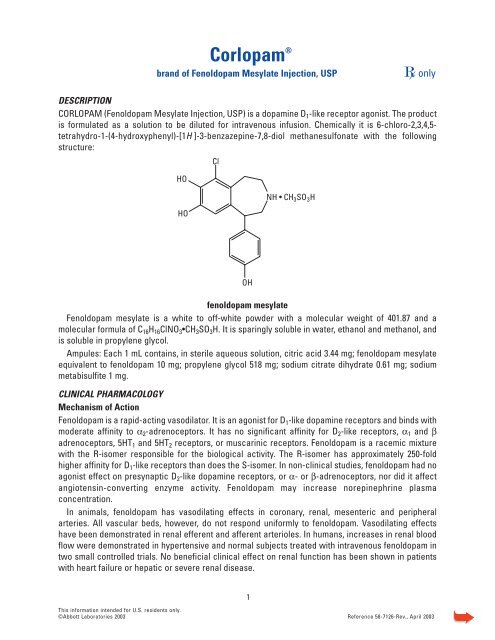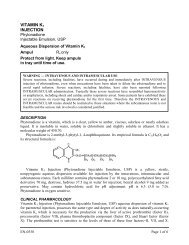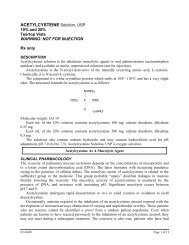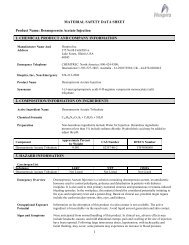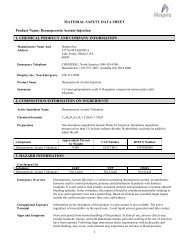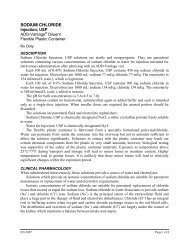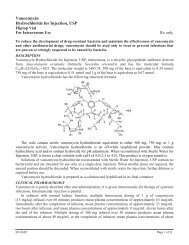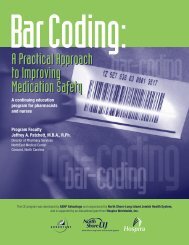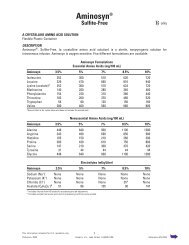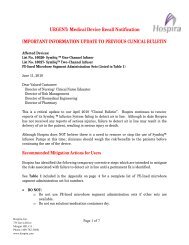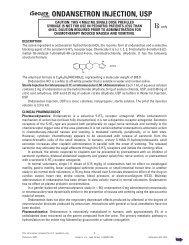Corlopam® - Hospira
Corlopam® - Hospira
Corlopam® - Hospira
Create successful ePaper yourself
Turn your PDF publications into a flip-book with our unique Google optimized e-Paper software.
Corlopam ®<br />
brand of Fenoldopam Mesylate Injection, USP � only<br />
DESCRIPTION<br />
CORLOPAM (Fenoldopam Mesylate Injection, USP) is a dopamine D 1-like receptor agonist. The product<br />
is formulated as a solution to be diluted for intravenous infusion. Chemically it is 6-chloro-2,3,4,5tetrahydro-1-(4-hydroxyphenyl)-[1H<br />
]-3-benzazepine-7,8-diol methanesulfonate with the following<br />
structure:<br />
HO<br />
HO<br />
Cl<br />
OH<br />
fenoldopam mesylate<br />
Fenoldopam mesylate is a white to off-white powder with a molecular weight of 401.87 and a<br />
molecular formula of C 16H 16ClNO 3•CH 3SO 3H. It is sparingly soluble in water, ethanol and methanol, and<br />
is soluble in propylene glycol.<br />
Ampules: Each 1 mL contains, in sterile aqueous solution, citric acid 3.44 mg; fenoldopam mesylate<br />
equivalent to fenoldopam 10 mg; propylene glycol 518 mg; sodium citrate dihydrate 0.61 mg; sodium<br />
metabisulfite 1 mg.<br />
CLINICAL PHARMACOLOGY<br />
Mechanism of Action<br />
Fenoldopam is a rapid-acting vasodilator. It is an agonist for D 1-like dopamine receptors and binds with<br />
moderate affinity to α2-adrenoceptors. It has no significant affinity for D 2-like receptors, α 1 and β<br />
adrenoceptors, 5HT 1 and 5HT 2 receptors, or muscarinic receptors. Fenoldopam is a racemic mixture<br />
with the R-isomer responsible for the biological activity. The R-isomer has approximately 250-fold<br />
higher affinity for D1-like receptors than does the S-isomer. In non-clinical studies, fenoldopam had no<br />
agonist effect on presynaptic D 2-like dopamine receptors, or α- or β-adrenoceptors, nor did it affect<br />
angiotensin-converting enzyme activity. Fenoldopam may increase norepinephrine plasma<br />
concentration.<br />
In animals, fenoldopam has vasodilating effects in coronary, renal, mesenteric and peripheral<br />
arteries. All vascular beds, however, do not respond uniformly to fenoldopam. Vasodilating effects<br />
have been demonstrated in renal efferent and afferent arterioles. In humans, increases in renal blood<br />
flow were demonstrated in hypertensive and normal subjects treated with intravenous fenoldopam in<br />
two small controlled trials. No beneficial clinical effect on renal function has been shown in patients<br />
with heart failure or hepatic or severe renal disease.<br />
This information intended for U.S. residents only.<br />
©Abbott Laboratories 2003 Reference 58-7126-Rev., April 2003<br />
1<br />
NH • CH 3SO 3H
Corlopam ®<br />
brand of Fenoldopam Mesylate Injection, USP<br />
Pharmacokinetics<br />
Administered as a constant infusion at rates of 0.01 to 1.6 mcg/kg/min, fenoldopam produced steadystate<br />
plasma concentrations that were proportional to infusion rates. The elimination half-life was<br />
about 5 minutes in mild to moderate hypertensives, with little difference between the R (active) and S<br />
isomers. Steady state concentrations are attained in about 20 minutes (4 half-lives). The steady state<br />
plasma concentrations of fenoldopam, at comparable infusion rates, were similar in normotensive<br />
subjects and in patients with mild to moderate hypertension or hypertensive emergencies (Table 1).<br />
Table 1<br />
CORLOPAM Plasma Concentrations in Normotensive, Mild to Moderate and Malignant Hypertensive<br />
Patients CORLOPAM PLASMA CONCENTRATION (ng/mL)<br />
Patient Populations<br />
CORLOPAM Normotensive Mild to Moderate Malignant<br />
Infusion Rate Subjects Hypertensive Hypertension<br />
(mcg/kg/min) Patients Patients<br />
n=10 n=7 n=20<br />
0.1 3.2 4.0 3.3<br />
Clearance of parent (active) fenoldopam is not altered in patients with end-stage renal disease on<br />
continuous ambulatory peritoneal dialysis (CAPD) and is not affected on average, in severe hepatic<br />
failure. The effects of hemodialysis on the pharmacokinetics of fenoldopam have not been evaluated.<br />
In radiolabeled studies in rats, no more than 0.005% of fenoldopam crossed the blood-brain barrier.<br />
Excretion and Metabolism<br />
Radiolabeled studies show that about 90% of infused fenoldopam is eliminated in urine, 10% in feces.<br />
Elimination is largely by conjugation, without participation of cytochrome P-450 enzymes. The principal<br />
routes of conjugation are methylation, glucuronidation, and sulfation. Only 4% of the administered dose<br />
is excreted unchanged. Animal data indicate that the metabolites are inactive.<br />
Special Population: The pharmacokinetics of fenoldopam were not influenced by age, gender, or<br />
race in hypertensive emergency patients. Effects of renal and hepatic dysfunction are described<br />
above. There have been no formal drug-drug interaction studies using intravenous fenoldopam.<br />
Pharmacodynamics and Clinical Studies<br />
In a randomized double-blind, placebo-controlled, 5-group study in 32 patients with mild to moderate<br />
essential hypertension (diastolic blood pressure between 95 and 119 mm Hg), and a mean baseline<br />
pressure of about 154/98 mm Hg, and heart rate of about 75 bpm, fixed-rate IV infusions of CORLOPAM<br />
produced dose-related reductions in systolic and diastolic blood pressure. Infusions were maintained<br />
at a fixed rate for 48 hours. Table 2 shows the results of the study. The onset of response was rapid at<br />
all infusion rates, with the 15-minute response representing 50-100% of the one-hour response in all<br />
groups. There was some suggestion of partial tolerance at 48 hours in the two higher dose infusions,<br />
but a substantial effect persisted through 48 hours. When infusions were stopped, blood pressure<br />
gradually returned to pretreatment values with no evidence of rebound. This study suggests that there<br />
is no greater response to 0.8 mcg/kg/min than to 0.4 mcg/kg/min.<br />
This information intended for U.S. residents only.<br />
©Abbott Laboratories 2003 Reference 58-7126-Rev., April 2003<br />
2
Corlopam ®<br />
brand of Fenoldopam Mesylate Injection, USP<br />
Table 2<br />
PHARMACODYNAMIC EFFECTS OF FENOLDOPAM IN MILD TO MODERATE HYPERTENSIVE PATIENTS<br />
Infusion Rate (mcg/kg/min)<br />
Time Point and Mean Placebo 0.04 0.1 0.4 0.8<br />
Change From Time n = 7 n = 7 n = 7 n = 5 n = 6<br />
Zero ± SE<br />
15 Minutes of Infusion*<br />
Systolic BP 0 ± 6 -15 ± 6 -19 ± 8 -14 ± 4 -24 ± 6<br />
Diastolic BP 0 ± 2 -5 ± 3 -12 ± 4 -15 ± 3 -20 ± 4<br />
Heart rate +2 ± 2 +3 ± 2 +5 ± 1 +16 ± 3 +19 ± 3<br />
30 Minutes of Infusion*<br />
Systolic BP -6 ± 5 -17 ± 6 -18 ± 6 -14 ± 8 -26 ± 6<br />
Diastolic BP -6 ± 3 -7 ± 3 -16 ± 4 -14 ± 3 -20 ± 2<br />
Heart rate +2 ± 2 +3 ± 2 +10 ± 2 +18 ± 3 +23 ± 3<br />
1 Hour of Infusion*<br />
Systolic BP -15 ± 4 -22 ± 7 -22 ± 7 -26 ± 9 -22 ± 9<br />
Diastolic BP -5 ± 3 -9 ± 2 -18 ± 4 -19 ± 4 -21 ± 1<br />
Heart rate +1 ± 3 +5 ± 2 +12 ± 3 +19 ± 4 +25 ± 4<br />
4 Hours of Infusion*<br />
Systolic BP -14 ± 5 -16 ± 9 -31 ± 15 -22 ± 11 -25 ± 7<br />
Diastolic BP -14 ± 8 -8 ± 4 -19 ± 9 -25 ± 3 -20 ± 1<br />
Heart rate +5 ± 3 +6 ± 3 +10 ± 4 +21 ± 2 +27 ± 7<br />
24 Hours of Infusion*<br />
Systolic BP -20 ± 6 -23 ± 8 -35 ± 7 -22 ± 6 -23 ± 11<br />
Diastolic BP -11 ± 6 -11 ± 5 -23 ± 10 -22 ± 5 -13 ± 3<br />
Heart rate +6 ± 3 +5 ± 3 +13 ± 2 +17 ± 4 +15 ± 3<br />
48 Hours of Infusion*<br />
Systolic BP -12 ± 8 -31 ± 6 -22 ± 8 -9 ± 6 -14 ±10<br />
Diastolic BP -9 ± 5 -10 ± 6 -9 ± 7 -9 ± 2 -9 ±3<br />
Heart rate +1 ± 2 0 ± 4 +1 ± 4 +12 ± 3 +8 ± 3<br />
*Mean change from time zero ± S.E.<br />
In a multicenter, randomized, double-blind comparison of four infusion rates, CORLOPAM was<br />
administered as constant rate infusions of 0.01, 0.03, 0.1 and 0.3 mcg/kg/min for up to 24 hours to 94<br />
patients experiencing hypertensive emergencies (defined as diastolic blood pressure ≥ 120 mm Hg<br />
with evidence of compromise of end-organ function involving the cardiovascular, renal, cerebral or<br />
retinal systems). Infusion rates could be doubled after one hour if clinically indicated. There were<br />
dose-related, rapid-onset, decreases in systolic and diastolic blood pressures and increases in heart<br />
rate (Table 3).<br />
This information intended for U.S. residents only.<br />
©Abbott Laboratories 2003 Reference 58-7126-Rev., April 2003<br />
3
Corlopam ®<br />
brand of Fenoldopam Mesylate Injection, USP<br />
Table 3<br />
PHARMACODYNAMIC EFFECTS OF FENOLDOPAM IN HYPERTENSIVE EMERGENCY PATIENTS<br />
Infusion Rate mcg/kg/min<br />
Time Point and 0.01 0.03 0.1 0.3<br />
Pharmacodynamic Parameters n = 25 n = 24 n = 22 n = 23<br />
Pre-Infusion Baseline<br />
Systolic BP - mean ± SE 210 ± 21 208 ± 26 205 ± 24 211 ± 17<br />
Diastolic BP - mean ± SE 136 ± 16 135 ± 11 133 ± 14 136 ± 15<br />
Heart rate - mean ± SE 87 ± 20 84 ± 14 81 ± 19 80 ± 14<br />
15 minutes of Infusion*<br />
Systolic BP -5 ±4 -7 ± 4 -16 ± 4 -19 ± 4<br />
Diastolic BP -5 ± 3 -8 ± 3 -12 ± 2 -21 ± 2<br />
Heart rate -2 ± 3 +1 ± 1 +2 ± 1 +11 ± 2<br />
30 Minutes of Infusion*<br />
Systolic BP -6 ± 4 -11 ± 4 -21 ± 3 -16 ± 4<br />
Diastolic BP -10 ± 3 -12 ± 3 -17 ± 3 -20 ± 2<br />
Heart rate -2 ± 3 -1 ± 1 +3 ± 2 +12 ± 3<br />
1 Hour of Infusion*<br />
Systolic BP -5 ± 3 -9 ± 4 -19 ± 4 -22 ±4<br />
Diastolic BP -8 ± 3 -13 ± 3 -18 ± 2 -23 ± 2<br />
Heart rate -1 ± 3 0 ± 2 +3 ± 2 +11 ± 3<br />
4 Hours of Infusion*<br />
Systolic BP -14 ± 4 -20 ± 5 -23 ± 4 -37 ± 4<br />
Diastolic BP -12 ± 3 -18 ± 3 -21 ± 3 -29 ± 3<br />
Heart rate -2 ± 4 0 ± 2 +4 ± 2 +11 ± 2<br />
* Mean change from baseline ± S.E.<br />
Two hundred and thirty six severely hypertensive patients (DBP ≥ 120 mm Hg), with or without endorgan<br />
compromise, were randomized to receive in two open-label studies either fenoldopam or<br />
nitroprusside. The response rate was 79% (92/117) in the fenoldopam group and 77% (90/119) in the<br />
nitroprusside group. Response required a decline in supine diastolic blood pressure to less than 110<br />
mm Hg if the baseline were between 120 and 150 mm Hg, inclusive, or by ≥ 40 mm Hg if the baseline<br />
were ≥ 150 mm Hg. Patients were titrated to the desired effect. For fenoldopam, the dose ranged from<br />
0.1 to 1.5 mcg/kg/min; for nitroprusside, the dose ranged from 1.0 to 8.0 mcg/kg/min. As in the study in<br />
mild to moderate hypertensives, most of the effect seen at one hour is present at 15 minutes. The<br />
additional effect seen after 1 hour occurs in all groups and may not be drug-related (there was no<br />
placebo group to evaluate this).<br />
INDICATIONS AND USAGE<br />
CORLOPAM is indicated for the in-hospital, short-term (up to 48 hours) management of severe<br />
hypertension when rapid, but quickly reversible, emergency reduction of blood pressure is clinically<br />
indicated, including malignant hypertension with deteriorating end-organ function. Transition to oral<br />
therapy with another agent can begin at any time after blood pressure is stable during CORLOPAM<br />
infusion.<br />
This information intended for U.S. residents only.<br />
©Abbott Laboratories 2003 Reference 58-7126-Rev., April 2003<br />
4
CONTRAINDICATIONS<br />
None known.<br />
Corlopam ®<br />
brand of Fenoldopam Mesylate Injection, USP<br />
WARNINGS<br />
Contains sodium metabisulfite, a sulfite that may cause allergic-type reactions including anaphylactic<br />
symptoms and life-threatening or less severe asthmatic episodes in certain susceptible people. The<br />
overall prevalence of sulfite sensitivity in the general population is unknown and probably low. Sulfite<br />
sensitivity is seen more frequently in asthmatic than in nonasthmatic people.<br />
PRECAUTIONS<br />
Intraocular Pressure: In a clinical study of 12 patients with open-angle glaucoma or ocular<br />
hypertension (mean baseline intraocular pressure was 29.2 mm Hg with a range of 22.0-33.0 mm Hg),<br />
infusion of CORLOPAM at escalating doses ranging from 0.05-0.5 mcg/kg/min over a 3.5 hour period<br />
caused a dose-dependent increase in intraocular pressure (IOP). At the peak effect, the intraocular<br />
pressure was raised by a mean of 6.5 mm Hg (range -2.0 to +8.5 mm Hg, corrected for placebo effect).<br />
Upon discontinuation of the CORLOPAM infusion, the IOP returned to baseline values within 2 hours.<br />
CORLOPAM administration to patients with glaucoma or intraocular hypertension should be<br />
undertaken with caution.<br />
Tachycardia: CORLOPAM causes a dose-related tachycardia (Table 2 and Table 3), particularly with<br />
infusion rates above 0.1 mcg/kg/min. Tachycardia diminishes over time but remains substantial at<br />
higher doses.<br />
Hypotension: CORLOPAM may occasionally produce symptomatic hypotension and close monitoring of<br />
blood pressure during administration is essential. (See Adverse Reactions.) It is particularly important<br />
to avoid systemic hypotension when administering the drug to patients who have sustained an acute<br />
cerebral infarction or hemorrhage.<br />
Hypokalemia: Decreases in serum potassium occasionally to values below 3.0 mEq/L were observed<br />
after less than 6 hours of fenoldopam infusion. It is not clear if the hypokalemia reflects a pressure<br />
natriuresis with enhanced potassium-sodium exchange or a direct drug effect. During clinical trials,<br />
electrolytes were monitored at intervals of 6 hours. Hypokalemia was treated with either oral or<br />
intravenous potassium supplementation. Patient management should include appropriate attention to<br />
serum electrolytes.<br />
Drug Interactions: Although there have been no formal interaction studies, intravenous CORLOPAM<br />
has been administered safely with drugs such as digitalis and sublingual nitroglycerin. There is limited<br />
experience with concomitant antihypertensive agents such as beta-blockers, alpha-blockers, calcium<br />
channel-blockers, ACE inhibitors, and diuretics (both thiazide-like and loop).<br />
Carcinogenesis, Mutagenesis, Impairment of Fertility: In a 24-month study, mice treated orally with<br />
fenoldopam at 12.5, 25, or 50 mg/kg/day, reduced to 25 mg/kg/day on day 209 of study, showed no<br />
increase above controls in the incidence of neoplasms. Female mice in the highest dose group had an<br />
increased incidence and degree of severity of a fibro-osseous lesion of the sternum compared with<br />
control or low-dose animals. Compared to controls, female mice in the middle- and upper-dose groups<br />
had a higher incidence and degree of severity of chronic nephritis. These pathologic lesions were not<br />
seen in male mice treated with fenoldopam.<br />
In a 24-month study, rats treated orally with fenoldopam at 5, 10 or 20 mg/kg/day, with the mid- and highdose<br />
groups increased to 15 or 25 mg/kg/day, respectively, on day 372 of the study, showed no increase above<br />
controls in the incidence or type of neoplasms. Compared with the controls, rats in the mid- and high-dose<br />
groups had a higher incidence of hyperplasia of collecting duct epithelium at the tip of the renal papilla.<br />
This information intended for U.S. residents only.<br />
©Abbott Laboratories 2003 Reference 58-7126-Rev., April 2003<br />
5
Corlopam ®<br />
brand of Fenoldopam Mesylate Injection, USP<br />
In in vitro assays, fenoldopam did not induce bacterial gene mutation in the Ames test or mammalian<br />
gene mutation in the Chinese hamster ovary (CHO) cell assay. In the in vitro chromosomal aberration<br />
assay with CHO cells, fenoldopam was associated with statistically significant and dose-dependent<br />
increases in chromosomal aberrations, and in the proportion of aberrant metaphases. However, no<br />
chromosomal damage was seen in the in vivo mice micronucleus or bone marrow assays. The data<br />
support the conclusion that fenoldopam is not genotoxic or clastogenic.<br />
Oral fertility and general reproduction performance studies in male and female rats at 12.5, 37.5 or 75<br />
mg/kg/day revealed no impairment of fertility or reproduction performance due to fenoldopam.<br />
Pregnancy: Pregnancy Category B. Oral reproduction studies have been performed in rats and rabbits<br />
at doses of 12.5 to 200 mg/kg/day and 6.25 to 25 mg/kg/day, respectively. Studies have revealed<br />
maternal toxicity at the highest doses tested but no evidence of impaired fertility or harm to the fetus<br />
due to fenoldopam. However, there are no adequate and well-controlled studies in pregnant women.<br />
Since animal reproduction studies are not always predictive of human response, fenoldopam should<br />
be used in pregnancy only if clearly needed.<br />
Nursing Mothers: Fenoldopam is excreted in milk in rats. It is not known whether this drug is excreted<br />
in human milk. Because many drugs are excreted in human milk, caution should be exercised when<br />
CORLOPAM is administered to a nursing woman.<br />
Pediatric Use: Safety and effectiveness in children have not been established.<br />
ADVERSE REACTIONS<br />
CORLOPAM causes a dose-related fall in blood pressure and increase in heart rate (see Precautions,<br />
Tachycardia, and Hypotension). In controlled clinical studies of severe hypertension in patients with<br />
end-organ damage, 3% (4/137) of patients withdrew because of excessive falls in blood pressure.<br />
Increased heart rate could, in theory, lead to ischemic cardiac events or worsened heart failure,<br />
although these events have not been observed. The most common events reported as associated with<br />
CORLOPAM use are headache, cutaneous dilation (flushing), nausea, and hypotension, each reported<br />
in more than 5% of patients.<br />
Adverse reactions in controlled trials in hypertension<br />
Adverse events occurring more than once in any dosing group (once if potentially important or<br />
plausibly drug-related) in the fixed-dose constant-infusion studies are presented in the following Table<br />
by infusion-rate group. There was no clear dose relationship, except possibly for headache, nausea,<br />
flushing.<br />
This information intended for U.S. residents only.<br />
©Abbott Laboratories 2003 Reference 58-7126-Rev., April 2003<br />
6
Corlopam ®<br />
brand of Fenoldopam Mesylate Injection, USP<br />
Table 4<br />
ADVERSE EVENTS* FROM FIXED-DOSE INFUSION STUDIES BY DOSE GROUP<br />
CORLOPAM Doses (mcg/kg/min)<br />
Placebo 0.01 0.03-0.04 0.1 0.3-0.4 0.6-0.8<br />
Body System Event (n = 7) (n = 26) (n = 31) (n = 28) (n = 29) (n = 11)<br />
Body, General Headache 1 5 4 7 8 6<br />
Injection site 0 1 3 0 3 2<br />
reaction<br />
Cardiovascular ST-T 0 2 4 0 1 0<br />
abnormalities<br />
(primarily T-wave<br />
inversion)<br />
Flushing 0 0 0 0 1 3<br />
Hypotension** 0 0 0 2 0 2<br />
Postural 0 2 0 0 0 0<br />
hypotension<br />
Tachycardia** 0 0 0 0 0 2<br />
Digestive Nausea 0 3 0 3 5 4<br />
Vomiting 0 2 0 2 1 2<br />
Abdominal pain/ 0 2 0 0 2 1<br />
fullness<br />
Constipation 0 0 0 0 0 2<br />
Diarrhea 0 0 0 0 2 0<br />
Metabolic and Increased 0 0 2 0 0 0<br />
Nutritional creatinine**<br />
Hypokalemia** 0 2 2 0 1 0<br />
Nervous Nervousness/ 0 0 1 0 0 2<br />
anxiety<br />
Insomnia 0 2 0 0 0 0<br />
Dizziness 0 1 1 2 2 0<br />
Respiratory Nasal congestion 0 0 0 0 0 2<br />
Skin and Sweating 0 0 0 1 1 2<br />
Appendages<br />
Urogenital Urinary tract 0 2 0 1 0 0<br />
infection<br />
Musculoskeletal Back pain 0 1 0 1 2 2<br />
* Includes events reported by 2 or more patients receiving CORLOPAM treatment across all dose<br />
groups.<br />
** Investigator defined; no protocol definition.<br />
This information intended for U.S. residents only.<br />
©Abbott Laboratories 2003 Reference 58-7126-Rev., April 2003<br />
7
Corlopam ®<br />
brand of Fenoldopam Mesylate Injection, USP<br />
Adverse effects in overall data base<br />
The adverse event incidences listed below are based on observations of over 1,000 CORLOPAM treated<br />
patients and not listed in the Table above.<br />
Events reported with a frequency between 0.5-5% in patients treated with IV CORLOPAM<br />
Cardiovascular: extrasystoles, palpitations, bradycardia, heart failure, ischemic heart<br />
disease, myocardial infarction, angina pectoris<br />
Metabolic: elevated BUN, elevated serum glucose, elevated transaminase, elevated LDH<br />
General Body: non-specific chest pain, pyrexia<br />
Hematologic/Lymphatic: leukocytosis, bleeding<br />
Respiratory: dyspnea, upper respiratory disorder<br />
Genitourinary: oliguria<br />
Musculoskeletal: limb cramp<br />
ANIMAL TOXICOLOGY<br />
Unusual toxicologic findings (arterial lesions in the rat) with fenoldopam are summarized below. These findings<br />
have not been observed in mice or dogs. No evidence of a similar lesion in humans has been observed.<br />
Arterial lesions characterized by medial necrosis and hemorrhage have been seen in renal and<br />
splanchnic arteries of rats given fenoldopam mesylate by continuous intravenous infusion at doses of<br />
1 to 100 mcg/kg/min for 24 hours. The incidence of these lesions is dose related. Arterial lesions<br />
morphologically identical to those observed with fenoldopam have been reported in rats infused with<br />
dopamine. Data suggest that the mechanism for this injury involves activation of D1-like dopaminergic<br />
receptors. Such lesions have not been seen in dogs given doses up to 100 mcg/kg/min by continuous<br />
intravenous infusion for 24 hours, nor were they seen in dogs infused at the same dose for 6 hours daily<br />
for 24 days. The clinical significance of this finding is not known.<br />
Oral administration of fenoldopam doses of 10 to 15 mg/kg/day or 20 to 25 mg/kg/day to rats for 24 months<br />
induced a higher incidence of polyarteritis nodosa compared to controls. Such lesions were not seen in rats<br />
given 5 mg/kg/day of fenoldopam or in mice given the drug at doses up to 50 mg/kg/day for 24 months.<br />
OVERDOSAGE<br />
Intentional CORLOPAM overdosage has not been reported. The most likely reaction would be excessive<br />
hypotension which should be treated with drug discontinuation and appropriate supportive measures.<br />
DOSAGE AND ADMINISTRATION<br />
The optimal magnitude and rate of blood pressure reduction in acutely hypertensive patients have not been<br />
rigorously determined, but, in general, both delay and too rapid decreases appear undesirable in sick<br />
patients. An initial CORLOPAM dose may be chosen from Tables 2 and 3 in the Clinical Pharmacology Section<br />
that produces the desired magnitude and rate of blood pressure reduction in a given clinical situation. Doses<br />
below 0.1 mcg/kg/min have very modest effects and appear only marginally useful in this population. In<br />
general, as the initial dose increases, there is a greater and more rapid blood pressure reduction. However,<br />
lower initial doses (0.03-0.1 mcg/kg/min) titrated slowly have been associated with less reflex tachycardia<br />
than have higher initial doses (≥ 0.3 mcg/kg/min). In clinical trials, doses from 0.01-1.6 mcg/kg/min have been<br />
studied. Most of the effect of a given infusion rate is attained in 15 minutes.<br />
CORLOPAM should be administered by continuous intravenous infusion. A bolus dose should not be<br />
used. Hypotension and rapid decreases of blood pressure should be avoided. The initial dose should<br />
be titrated upward or downward, no more frequently than every 15 minutes (and less frequently as goal<br />
pressure is approached) to achieve the desired therapeutic effect. The recommended increments for<br />
titration are 0.05-0.1 mcg/kg/min.<br />
This information intended for U.S. residents only.<br />
©Abbott Laboratories 2003 Reference 58-7126-Rev., April 2003<br />
8
Corlopam ®<br />
brand of Fenoldopam Mesylate Injection, USP<br />
Use of a calibrated, mechanical infusion pump is recommended for proper control of infusion rate<br />
during CORLOPAM infusion. In clinical trials, CORLOPAM treatment was safely performed without the<br />
need for intra-arterial blood pressure monitoring; blood pressure and heart rate were monitored at<br />
frequent intervals, typically every 15 minutes. Frequent blood pressure monitoring is recommended.<br />
Use of beta-blockers in conjunction with CORLOPAM has not been studied in hypertensive patients<br />
and, if possible, concomitant use should be avoided. If the drugs are used together, caution should be<br />
exercised because unexpected hypotension could result from beta-blocker inhibition of the reflex<br />
response to fenoldopam.<br />
The CORLOPAM infusion can be abruptly discontinued or gradually tapered prior to discontinuation.<br />
Oral antihypertensive agents can be added during CORLOPAM infusion or following its discontinuation.<br />
Patients in controlled clinical trials have received intravenous CORLOPAM for as long as 48 hours.<br />
PREPARATION OF INFUSION SOLUTION<br />
WARNING: CONTENTS OF AMPULES MUST BE DILUTED BEFORE INFUSION. EACH AMPULE IS FOR<br />
SINGLE USE ONLY.<br />
Dilution:<br />
The CORLOPAM Injection ampule concentrate must be diluted in 0.9% Sodium Chloride Injection USP<br />
or 5% Dextrose Injection USP using the following dilution schedule:<br />
mL of Concentrate (mg of drug) Added to Final Concentration<br />
4 mL (40 mg) 1000 mL 40 mcg/mL<br />
2 mL (20 mg) 500 mL 40 mcg/mL<br />
1 mL (10 mg) 250 mL 40 mcg/mL<br />
The drug dose rate must be individualized according to body weight and according to the desired<br />
rapidity and extent of pharmacodynamic effect. The following Table provides the calculated infusion<br />
volume in mL/min for a range of drug doses and body weights. The infusion should be administered<br />
using a calibrated mechanical infusion pump that can accurately and reliably deliver the desired<br />
infusion rate.<br />
Table 5<br />
INFUSION RATES (mL/min) TO ACHIEVE A GIVEN DRUG DOSE RATE (mcg/kg/min)<br />
Drug Dose Rate<br />
Body Weight 0.025 0.05 0.1 0.2 0.3<br />
(kg) mcg/kg/min mcg/kg/min mcg/kg/min mcg/kg/min mcg/kg/min<br />
Infusion Rates (mL/min)<br />
40 0.025 0.05 0.10 0.20 0.30<br />
50 0.031 0.06 0.13 0.25 0.38<br />
60 0.038 0.08 0.15 0.30 0.45<br />
70 0.044 0.09 0.18 0.35 0.53<br />
80 0.050 0.10 0.20 0.40 0.60<br />
90 0.056 0.11 0.23 0.45 0.68<br />
100 0.063 0.13 0.25 0.50 0.75<br />
110 0.069 0.14 0.28 0.55 0.83<br />
120 0.075 0.15 0.30 0.60 0.90<br />
130 0.081 0.16 0.33 0.65 0.98<br />
140 0.088 0.18 0.35 0.70 1.05<br />
150 0.094 0.19 0.38 0.75 1.13<br />
This information intended for U.S. residents only.<br />
©Abbott Laboratories 2003 Reference 58-7126-Rev., April 2003<br />
9
Corlopam ®<br />
brand of Fenoldopam Mesylate Injection, USP<br />
The diluted solution is stable under normal ambient light and temperature conditions for at least 24<br />
hours. Diluted solution that is not used within 24 hours of preparation should be discarded. Parenteral<br />
products should be inspected visually. If particulate matter or cloudiness is observed, the drug should<br />
be discarded.<br />
HOW SUPPLIED<br />
List Container Concentration Fill Quantity<br />
2304 Single-dose ampule 10 mg/mL 1 mL one per carton<br />
2304 Single-dose ampule 10 mg/mL 2 mL one per carton<br />
Store at 2 to 30°C.<br />
Revised April, 2003<br />
Ref: 58-7126<br />
©Abbott 2003 Printed in USA<br />
ABBOTT LABORATORIES, NORTH CHICAGO, IL 60064, USA<br />
10<br />
This information intended for U.S. residents only.<br />
©Abbott Laboratories 2003 Reference 58-7126-Rev., April 2003


